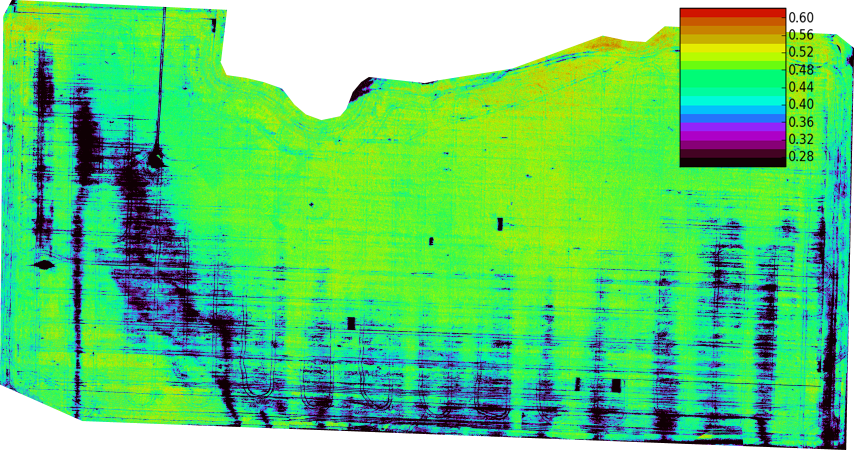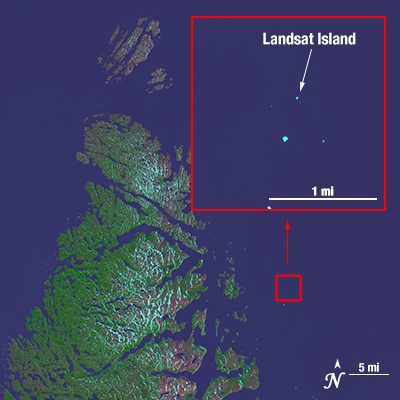|
Earth Resources Technology Satellite
Landsat 1 (LS-1), formerly named ERTS-A and ERTS-1, was the first satellite of the United States' Landsat program. It was a modified version of the Nimbus 4 Meteorology, meteorological satellite and was launched on July 23, 1972, by a Delta 0100, Delta 900 rocket from Vandenberg Air Force Base in California. It was the first satellite to carry a Multispectral Scanner. The near-polar orbiting spacecraft served as a stabilized, Earth-oriented platform for obtaining information on agricultural and forestry resources, geology and mineral resources, hydrology and water resources, geography, cartography, environmental pollution, oceanography and marine resources, and meteorological phenomena. Background The multi-agency Earth Resources Satellites Program was begun in 1966 by the Department of the Interior. The goal of the program was to gather data from the Earth via remote sensing techniques. The following year a feasibility study was performed for the Earth Resources Technology S ... [...More Info...] [...Related Items...] OR: [Wikipedia] [Google] [Baidu] |
Nimbus Program
The Nimbus satellites were second-generation U.S. robotic spacecraft launched between 1964 and 1978 used for meteorological research and development. The spacecraft were designed to serve as stabilized, Earth-oriented platforms for the testing of advanced systems to sense and collect atmospheric science data. Seven Nimbus spacecraft have been launched into near-polar, sun-synchronous orbits beginning with Nimbus 1 on August 28, 1964. On board the Nimbus satellites are various instrumentation for imaging, sounding, and other studies in different spectral regions. The Nimbus satellites were launched aboard Thor-Agena rockets (Nimbus 1–4) and Delta rockets (Nimbus 5–7). Over a 20-year period from the launch of the first satellite, the Nimbus series of missions was the United States' primary research and development platform for satellite remote sensing of the Earth. The seven Nimbus satellites, launched over a fourteen-year period, shared their space-based observations ... [...More Info...] [...Related Items...] OR: [Wikipedia] [Google] [Baidu] |
General Electric
General Electric Company (GE) is an American multinational conglomerate founded in 1892, and incorporated in New York state and headquartered in Boston. The company operated in sectors including healthcare, aviation, power, renewable energy, digital industry, additive manufacturing and venture capital and finance, but has since divested from several areas, now primarily consisting of the first four segments. In 2020, GE ranked among the Fortune 500 as the 33rd largest firm in the United States by gross revenue. In 2011, GE ranked among the Fortune 20 as the 14th most profitable company, but later very severely underperformed the market (by about 75%) as its profitability collapsed. Two employees of GE – Irving Langmuir (1932) and Ivar Giaever (1973) – have been awarded the Nobel Prize. On November 9, 2021, the company announced it would divide itself into three investment-grade public companies. On July 18, 2022, GE unveiled the brand names of the companies it will ... [...More Info...] [...Related Items...] OR: [Wikipedia] [Google] [Baidu] |
Normalized Difference Vegetation Index
The normalized difference vegetation index (NDVI) is a simple graphical indicator that can be used to analyze remote sensing measurements, often from a space platform, assessing whether or not the target being observed contains live green vegetation. Brief history The exploration of outer space started in earnest with the launch of Sputnik 1 by the Soviet Union on 4 October 1957. This was the first man-made satellite orbiting the Earth. Subsequent successful launches, both in the Soviet Union (e.g., the Sputnik and Cosmos programs), and in the U.S. (e.g., the Explorer program), quickly led to the design and operation of dedicated meteorological satellites. These are orbiting platforms embarking instruments specially designed to observe the Earth's atmosphere and surface with a view to improve weather forecasting. Starting in 1960, the TIROS series of satellites embarked television cameras and radiometers. This was later (1964 onwards) followed by the Nimbus satellites and t ... [...More Info...] [...Related Items...] OR: [Wikipedia] [Google] [Baidu] |
Landsat Island
Landsat Island is a small, uninhabited island located at approximately 60°10'37"N 64°02'30"W, off the northeast coast of Labrador (part of the Canadian province of Newfoundland and Labrador). It was discovered in 1976 during the analysis of imagery from the Landsat 1 satellite. The island is only , with a total area of . Discovery In 1976, a Canadian coastal survey was carried out using data from the Landsat 1 satellite. Analysis of the data revealed several previously uncharted features; this includes Landsat Island, which was subsequently named after the satellite. Verification of the island's existence fell to Dr. Frank Hall of the Canadian Hydrographic Service ''Retired Canadian Hydrographic Service logo or crest'' The Canadian Hydrographic Service (CHS) is part of the federal department of Fisheries and Oceans Canada and is Canada's authoritative hydrographic office. The CHS represents Canada in t ...: Following Dr. Hall's encounter with the polar bear, it was sug ... [...More Info...] [...Related Items...] OR: [Wikipedia] [Google] [Baidu] |
Landsat 1 Launch
The Landsat program is the longest-running enterprise for acquisition of satellite imagery of Earth. It is a joint NASA / USGS program. On 23 July 1972, the Earth Resources Technology Satellite was launched. This was eventually renamed to Landsat 1 in 1975. The most recent, Landsat 9, was launched on 27 September 2021. The instruments on the Landsat satellites have acquired millions of images. The images, archived in the United States and at Landsat receiving stations around the world, are a unique resource for global change research and applications in agriculture, cartography, geology, forestry, regional planning, surveillance and education, and can be viewed through the U.S. Geological Survey (USGS) "EarthExplorer" website. Landsat 7 data has eight spectral bands with spatial resolutions ranging from ; the temporal resolution is 16 days. Landsat images are usually divided into scenes for easy downloading. Each Landsat scene is about 115 miles long and 115 miles wide (or 100 ... [...More Info...] [...Related Items...] OR: [Wikipedia] [Google] [Baidu] |
Virginia T
Virginia, officially the Commonwealth of Virginia, is a state in the Mid-Atlantic and Southeastern regions of the United States, between the Atlantic Coast and the Appalachian Mountains. The geography and climate of the Commonwealth are shaped by the Blue Ridge Mountains and the Chesapeake Bay, which provide habitat for much of its flora and fauna. The capital of the Commonwealth is Richmond; Virginia Beach is the most-populous city, and Fairfax County is the most-populous political subdivision. The Commonwealth's population was over 8.65million, with 36% of them living in the Baltimore–Washington metropolitan area. The area's history begins with several indigenous groups, including the Powhatan. In 1607, the London Company established the Colony of Virginia as the first permanent English colony in the New World. Virginia's state nickname, the Old Dominion, is a reference to this status. Slave labor and land acquired from displaced native tribes fueled the growing pl ... [...More Info...] [...Related Items...] OR: [Wikipedia] [Google] [Baidu] |
Near Infrared
Infrared (IR), sometimes called infrared light, is electromagnetic radiation (EMR) with wavelengths longer than those of visible light. It is therefore invisible to the human eye. IR is generally understood to encompass wavelengths from around 1 millimeter (300 GHz) to the nominal red edge of the visible spectrum, around 700 nanometers (430 THz). Longer IR wavelengths (30 μm-100 μm) are sometimes included as part of the terahertz radiation range. Almost all black-body radiation from objects near room temperature is at infrared wavelengths. As a form of electromagnetic radiation, IR propagates energy and momentum, exerts radiation pressure, and has properties corresponding to both those of a wave and of a particle, the photon. It was long known that fires emit invisible heat; in 1681 the pioneering experimenter Edme Mariotte showed that glass, though transparent to sunlight, obstructed radiant heat. In 1800 the astronomer Sir William Herschel discovered ... [...More Info...] [...Related Items...] OR: [Wikipedia] [Google] [Baidu] |
Visible Light
Light or visible light is electromagnetic radiation that can be perceived by the human eye. Visible light is usually defined as having wavelengths in the range of 400–700 nanometres (nm), corresponding to frequencies of 750–420 terahertz, between the infrared (with longer wavelengths) and the ultraviolet (with shorter wavelengths). In physics, the term "light" may refer more broadly to electromagnetic radiation of any wavelength, whether visible or not. In this sense, gamma rays, X-rays, microwaves and radio waves are also light. The primary properties of light are intensity, propagation direction, frequency or wavelength spectrum and polarization. Its speed in a vacuum, 299 792 458 metres a second (m/s), is one of the fundamental constants of nature. Like all types of electromagnetic radiation, visible light propagates by massless elementary particles called photons that represents the quanta of electromagnetic field, and can be analyzed as both waves and ... [...More Info...] [...Related Items...] OR: [Wikipedia] [Google] [Baidu] |
Vidicon
Video camera tubes were devices based on the cathode ray tube that were used in television cameras to capture television images, prior to the introduction of charge-coupled device (CCD) image sensors in the 1980s. Several different types of tubes were in use from the early 1930s, and as late as the 1990s. In these tubes, an cathode ray, electron beam was scanned across an image of the scene to be broadcast focused on a target. This generated a current that was dependent on the brightness of the image on the target at the scan point. The size of the striking ray was tiny compared to the size of the target, allowing 483 horizontal scan lines per image in the NTSC format, 576 lines in PAL, and as many as 1035 lines in Multiple sub-Nyquist sampling encoding, Hi-Vision. Cathode ray tube Any vacuum tube which operates using a focused beam of electrons, originally called cathode rays, is known as a cathode ray tube (CRT). These are usually seen as display devices as used in older (i.e. ... [...More Info...] [...Related Items...] OR: [Wikipedia] [Google] [Baidu] |
Video Tape
Videotape is magnetic tape used for storing video and usually sound in addition. Information stored can be in the form of either an analog or digital signal. Videotape is used in both video tape recorders (VTRs) and, more commonly, videocassette recorders (VCRs) and camcorders. Videotapes have also been used for storing scientific or medical data, such as the data produced by an electrocardiogram. Because video signals have a very high bandwidth, and stationary heads would require extremely high tape speeds, in most cases, a helical-scan video head rotates against the moving tape to record the data in two dimensions. Tape is a linear method of storing information and thus imposes delays to access a portion of the tape that is not already against the heads. The early 2000s saw the introduction and rise to prominence of high-quality random-access video recording media such as hard disks and flash memory. Since then, videotape has been increasingly relegated to archival and simi ... [...More Info...] [...Related Items...] OR: [Wikipedia] [Google] [Baidu] |
Valley Forge, Pennsylvania
The Village of Valley Forge is an unincorporated settlement located on the west side of Valley Forge National Historical Park at the confluence of Valley Creek and the Schuylkill River in Pennsylvania. The remaining village is in Schuylkill Township of Chester County, but once spanned Valley Creek into Montgomery County. The name Valley Forge is often used to refer to anywhere in the general vicinity of the park, and many places actually in King of Prussia, Trooper, Oaks, and other nearby communities will use the name, leading to some ambiguity on the actual location of the modern village. There is a partial re-creation of the historic village from the time of the American Revolution that is located next door, and just within the outskirts of the park. Valley Forge is known by travelers in the Philadelphia area as the westbound control city on Interstate 76 (the Schuylkill Expressway), as it is near where I-76 joins the Pennsylvania Turnpike. This remains, despite no exit b ... [...More Info...] [...Related Items...] OR: [Wikipedia] [Google] [Baidu] |






.jpg)